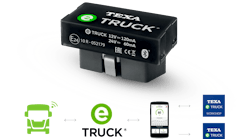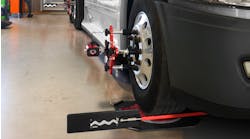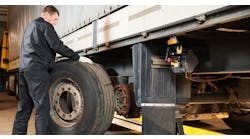The emissions warning light the driver has been ignoring all day is now flashing and the truck has entered derate. Does this scenario sound familiar? The fleet must make a decision on how best to deal with the emissions failure in the field.
If the fleet is fortunate enough to have some form of telematics capabilities available to remotely gather information from the vehicle and send it back to the shop, the diagnostic trouble code (DTC) can be identified. And, if enough data is present, the fleet might even be able to obtain a preliminary diagnosis.
This information is required in order to make an educated decision to either send a tow truck or a field technician to the downed vehicle.
Facing additional obstacles without telematics
First, imagine how fleets today conduct a preliminary emissions-related roadside breakdown diagnosis, without access to a telematics system.
Say the fleet either does not have a field technician available or has a standard operating procedure of dispatching a tow truck to retrieve the downed vehicle.
Without the advanced telematics system in place the diagnosis will have to wait until the vehicle arrives back to the shop, and then parts can be ordered. This is likely the least efficient way of dealing with the complexities that computer-controlled systems and emissions failures have created.
If a field technician is sent, the technician arrives and performs on-site diagnostics. As an example, say he or she determines that the DEF quality sensor is at fault for the emission failure. But, the technician doesn’t have a replacement sensor part on-hand.
The fleet now either needs to send another person to the location with the part or the technician needs to go retrieve one.
Taking this example a step further, imagine that the part or repair is not something that can or should be serviced in the field. There is no way of knowing the extent of the service or repair until the field technician is dispatched and arrives on-site to evaluate the situation. In this instance, a tow truck is needed. This scenario is one of the costliest in terms of downtime and lost efficiency.
The benefits of telematics information
Now, consider the availability of a telematics system on the downed vehicle. A fleet may send a field technician in an attempt to put the vehicle back in service as quickly as possible. That technician will already know the DTCs present, and possibly a preliminary diagnosis, before arriving.
The technician will need additional correct diagnostic software available in the field. Next, the field technician will also need the correct part for the year, make and model of this vehicle. If a comprehensive telematics system is installed and the fleet was able to perform a preliminary diagnosis there is a far better chance of having the needed parts on the first trip.
The technician arrives, makes the repair, performs the emissions reset, forces the regen and the vehicle is back in service.
In this best-case scenario, by using the telematics data from the downed vehicle, the fleet can increase efficiency and minimize downtime.
Even in the case of dispatching a tow truck first, with an advanced telematics system in place, the fleet could still have performed a preliminary diagnosis of the vehicle remotely and, as a result, be better prepared for the repair when the truck arrives at the shop.
The future of vehicle telematics
The concept of vehicle telematics is not new. In almost all cases telematics has been a passive implementation providing fault codes and limited data, but lacking any advanced bi-directional capabilities.
Historically, in design and in practice, the idea has been to connect vehicle owners with the dealership or aftermarket service center. Telematics has provided the ability for remote diagnosis and better follow-up on vehicle maintenance by connecting the service center, vehicle owner and the vehicle in real-time.
Why stop there? Recently there have been strides in the industry to utilize this technology to better combat the unrelenting emissions failures that most fleets have faced.
Medium duty and heavy duty vehicles many times go into derate in one form or another simply because the prerequisites for a passive regen are not met, or the driver has bypassed the regen. There is not a part failure; the vehicle simply needs to have the applicable emissions parameters reset and forced regen must be performed to put it back in service. Based on industry feedback from field technicians, shop owners and fleet managers, this seems to be a common situation among many fleets.
Now, what if the fleet could perform the reset or forced regen without leaving the shop, sending a tow truck or a field technician? Imagine the increased vehicle uptime for the fleet with this type of bi-directional functionality.
Locklear has more than two decades of experience in the transportation industry, in various leadership positions. In 2009, Locklear formed Cutting Edge Automotive Solutions. In 2013, he began working with TEXA S.p.A. with the company’s product and market development for North America. Cutting Edge Automotive Solutions is now the main distributor of TEXA products in North America.



